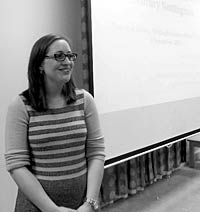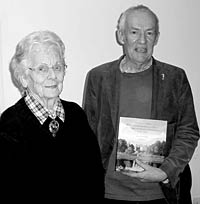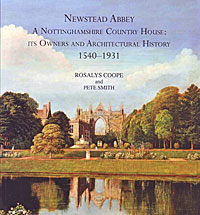Events and excursions, Winter 2014-15
The Nottingham History Lecture, 8 November 2014.
Teresa Phipps - Gendered Justice? Women, law and community in fourteenth century Nottingham.
Report by Hannah Nicholson

On the 8th November we welcomed Teresa Phipps from the University of Nottingham.
Teresa's lecture was based upon her recently submitted Ph.D. thesis which used the records from Nottingham's borough courts to explore the legal actions and status of women within the town using those from the courts of Chester and Winchester by way of comparison.
Women were present within all areas of commercial life and appear in the records as both creditors and debtors. Though in the majority of cases, married women appeared in the records alongside their husbands, Teresa argued that this was not so much evidence that their legal identity and responsibilities were subsumed by their husband but rather that they acted together in court matters. Single women were accountable to their debts within court and were able to act as creditors in their own right recalling any money owing to them.
Many of the cases brought to court by women were involved with the production and sale of food and drink such as the case from 1395 brought against Richard and Agnes Brass by Isabella Whechnor for the 2s she was owed for ale with other cases highlighting women's involvement within the textile trade. Instances of assault also featured regularly amongst the borough court cases with women being more likely to be presented to court as the perpetrator of violence rather than the victim of it.
Teresa concluded her talk by suggesting that on the whole, the borough courts of Nottingham were not concerned with gender or marital status. Men and women were, on the whole, treated equally in the eyes of the court. Both were held to be accountable to the same standards of behaviour in economic and social life and were equally able to bring cases of misdemeanours against them to the borough court.
The Neville Hoskins Lecture and Newstead Abbey Book Launch, 13 December 2014
Report by Adrian Henstock

Rosalys Coope and Pete Smith, (photo: David Hoskins).

This lecture took the rare format of being combined with the launch of the latest Record Series publication. This volume is itself also unusual in that it takes the form of a monograph - a whole book devoted to a specific topic - in this case the architectural history of Newstead Abbey over 800 years. The previous precedent for such a publication was a similar study of Nottingham Castle issued in 1989.
The new book gathers together in a single chronological narrative a series of articles on different phases of the Abbey's architectural history published in Transactions over a period of 35 years by our former President, Dr. Rosalys Coope.
Before the lecture began copies of the book were formally presented to Rosalys, to her son-in-law, Professor Robert Lumley, who had originally suggested the volume, and to Pete Smith, who has both contributed to and edited the publication. Rosalys then spoke and explained that some of her early articles had needed revising and extending in the light of new research - particularly an archaeological survey of the building fabric by Colin Brydon and the evidence offered by historical images of the house recently identified by Pete Smith and other collaborators. These revisions have been incorporated into the new book.
The lecture was then delivered on behalf of both authors by Pete - who is a retired English Heritage buildings surveyor and a member of the Society's Council - illustrated by a selection of the superb drawings, paintings, and engravings of the Abbey since c1700 which he has accumulated. These even include views of c1818 painted on a set of Sevres dinner plates.
He proceeded to demonstrate skillfully how these images had been used by Rosalys and himself to unravel the complex architectural development of the building from its foundation as a priory in c1163. For example Newstead is most unusual amongst Augustinian foundations for have a church without a south aisle, its position being taken up largely by the north cloister walk, but this is ingeniously disguised externally by the symmetrical West Front which still stands today.
As a result of the Dissolution of the Monasteries the priory was acquired in 1539 by the Byron family who adapted it as a country house and lived in it under the name of Newstead Abbey until 1817 when it was sold by the 6th Lord Byron the poet. Each new generation of the family made their mark on the fabric and layout, and Rosalys and Pete wished to emphasize the major contribution of the 5th Lord Byron in the Georgian period. He lavished so much money on 'Gotheking' the house and the park that he virtually bankrupted the estate by the 1770s, earning himself the perhaps undeserved epithet of the 'Wicked Lord'. His building legacy still survives in the house and particularly in the grounds. Here his passion for re-enacting naval battles by scaled-down sailing ships motivated him to erect mock forts known as the Battery, Kennels Castle, and the (now lost) Folly Castle around the lake.
However Rosalys and Pete were anxious to remind us that much of the Abbey's fabric which we see today is not due to the Byrons but to the Wildman family between 1817 and 1859 and their successors the Webbs between 1860 and 1925. In particular Colonel Thomas Wildman - who came from a nouveau riche family - set about a major programme of what was known to contemporaries as 'early-ing up' the house in neo-medieval style; Rosalys considers that his emphasis on its antiquity was probably to compensate for the absence of an ancient ancestral heritage himself. He rebuilt and extended much of the work of the earlier builders.
The lecture was an excellent introduction to the book which is lavishly illustrated with 112 plates and diagrams, many in full colour, and a worthy tribute to Dr. Rosalys Coope, especially as she undertook to work on the textural revisions at the age of 93.
Newstead Abbey: a Nottinghamshire Country House: its Owners and Architectural History 1540-1931. Thoroton Society Record Series, vol. 48,214 pp. (2014). ISBN 978-0-902719-26-2The book is free to Record series subscribers. Otherwise Price £20 (£25 post paid, UK; overseas at cost) or £15 to members of main Society (£20 post paid UK; overseas at cost).
For further information contact the Hon. Treasurer John Wilson (wilsonicusi@gmail.com).
The Norah Witham Lecture, 10 January 2015
Gwilym Dodd - Agincourt: England's Hollow Victory
Report by David Crook

2015 is an important year for centernaries, and during it we are to have three lectures based around them. Later there will be papers on the age of the battle of Waterloo and on Magna Carta, but the year began with the January lecture by Dr. Gwilym Dodd of the University of Nottingham, about the battle of Agincourt (now Azincourt), fought on St. Crispin's day (25 October) 1415, which he argued turned out to be only a hollow victory for the English.
In the battle King Henry V defeated a larger French force in a remarkable victory which seemed to sustain his claim to the throne of France, and which was eventually immortalised in one of Shalespeare's most accomplished history plays nearly 200 years later.
Dr. Dodd argued that, although it was indisputedly a great military victory, the battle raised questions about the quality of the king's leadership, and had the effect of enticing him to pursue over-ambitious and ultimately unrealistic political and military goals.
The English force consisted of about 6,000 men, 5,000 of them being archers, while the French probably had about four times than number, including about 10,000 men-at-arms. With such odds the English victory was remarkable, but they were greatly assisted by French mistakes, especially permitting the English to make the best use of the terrain and allowing themselves to be drawn into battle prematurely, before they were fully ready. It could therefore be argued that the French lost the battle rather than that the English won it.
The English had been in a weak position because of earlier strategic errors which led the army to a long and circuitous march towards Calais after the campaign began with the debilitating seige of Harfleur; a more sensible option, to sail back to England, was prevented by the king's rashness, resulting from his personal pride and impetuosity.
Nevertheless, the victory cost the French many of their leading men, who were either killed or taken prisoner, giving the victorious English the opportunity to conquer more of the French kingdom. Normandy was taken by 1419, and
in 1420 the treaty of Troyes led to Henry's marriage to the French King's daughter, Katherine, and his acceptance as heir to the French throne. However, and after further relatively unsuccessful campaigning to take the rest of the country from the Dauphin, Henry died a few weeks before his father-in-law in 1422, and never became King of France.
The war for the control over the rest of the kingdom continued for three more decades under his ineffective son, Henry VI, and was eventually lost in 1453. Ultimately, Agincourt proved to be a hollow vistory because it aroused unrealistic English expectations for continued success in the war to claim the French throne for the Plantagenet dynasty.
The positive impact of the lecture was indicated by the number and quality of the questions with which the session ended. They ranged over matters such as the recruitment of archers and their role in battle, the strategic considerations behind the shape of the campaign, and the controversial question of the relative strengths of the two armies, some other historians having recently argued that the relative superiority of the French over the English has been much exaggerated.
Dr. Dodd's answers to these and other queries elicited a very positive response, and the lecture was much enjoyed by the Society's members who attended. The lecture proved to be an excellent start to what promises to be an exciting programme throughout the year.